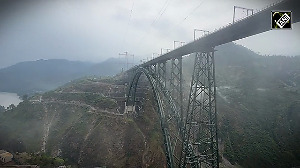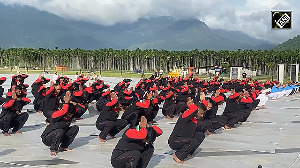India will join an elite group of nations with Wednesday's launch of a new mission to test re-entry technology, which would be a forerunner to developing reusable vehicles like space shuttles.
Indian Space Research Organisation's reliable workhorse -- launch vehicle PSLV-C7 will soar into the skies from the spaceport in Sriharikota and hurtle into space four payloads, including the 550 kg Space Capsule Recovery Experiment.
With this, India will join an elite class of countries possessing this SRE technology -- the United States, Russia and China.
The T-52 hour countdown for the launch of the PSLV-C7 began at 0548 hours on Monday, and it was progessing smoothly.
The PSLV-C7, in its tenth flight will launch India's remote sensing satellite CARTOSAT-2 (680 kg), besides Indonesia's earth observation satellite LAPAN-TUBSAT (56 kg) and Argentina's nano-satellite PEHUENSAT-1 (six kg) into a 635 km high polar sun synchronous orbit.
The SRE-1, after being in orbit for 13 to 30 days, would be de-orbited and will splash down in the Bay of Bengal, about 140 km east of Sriharikota coast.
A floatation system will keep the capsule afloat and it would be recovered by the Coast Guard.
"When the SRE descends from its orbit, its three parachutes will open one after another when it is 5 km above the waters of the Bay of Bengal, and commands given to drop down," ISRO sources told UNI.
During its stay in orbit, the SRE-1 will demonstrate the technology of orbiting platform for performing experiments in micro-gravity conditions, it added.
The SRE-1 will provide important technology inputs in navigation, guidance and control during the re-entry phase, hypersonic aero-thermoynamics for resuable thermal protection system, recovery through deceleration and floatation besides acquisition of basic technology for reusable launch vehicles.
SRE-1 will carry two experiments -- an Isothermal Heating Furnace and a biomimetic experiment. During its stay in orbit, the two payloads will be operated. While IHF would be operated to perform metallurgical experiments, the other experiment would be operated to perform biomimetic synthesis.
To enable the PSLV-C7 to launch four satellites in four different orbits, a Dual Launch Adopter is being used for the first time.
While CARTOSAT-2 was mounted over DLA, the SRE was positioned inside the DLA. The LAPAN-TUBSAT was mounted on equipment bay and the Argentinian satellite also mounted on DLA.






